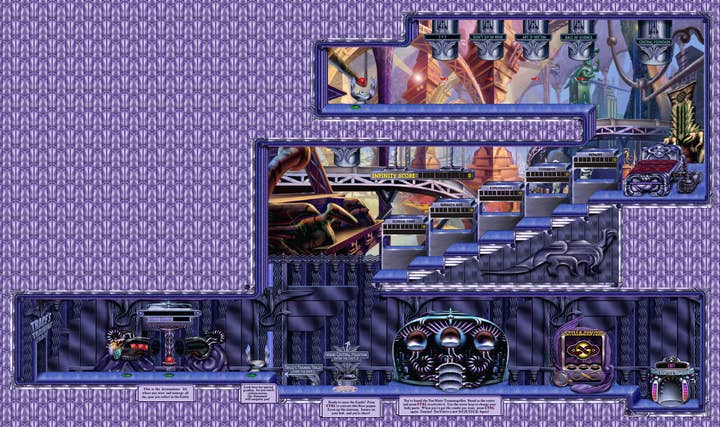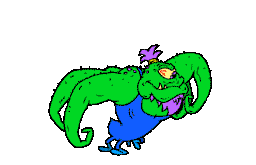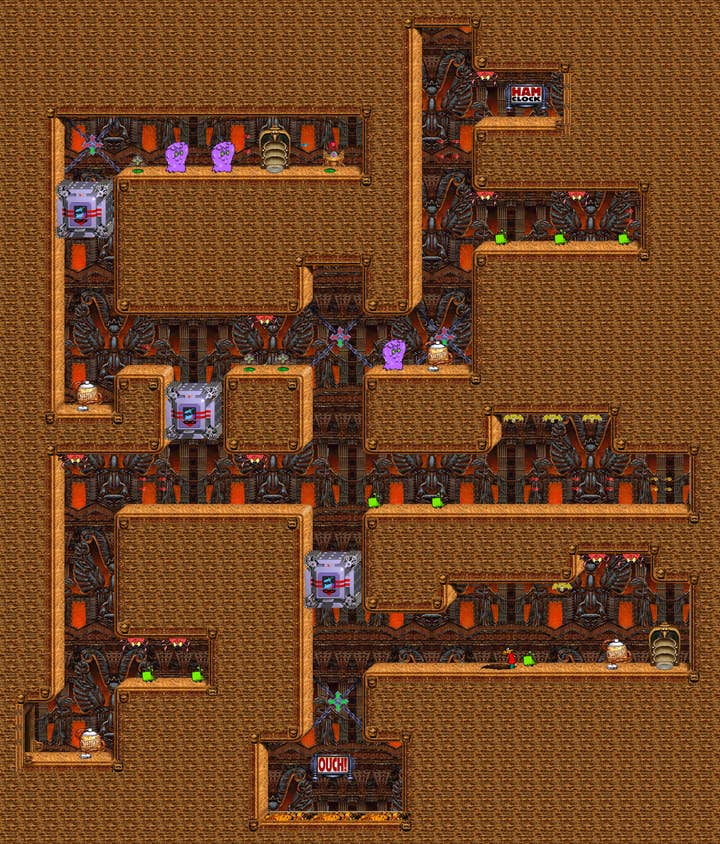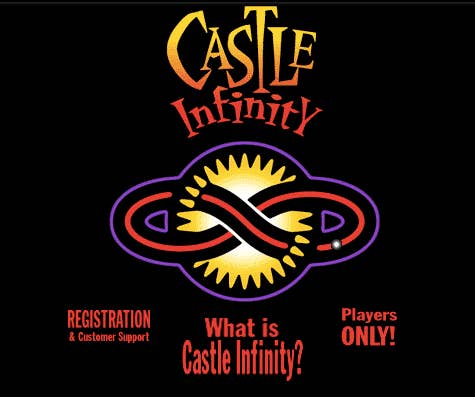A Limited History of Castle Infinity
A love letter to a lost digital childhood from Kim Belair
I've worked in the games industry for just over three years now, and I've loved video games since I first played Duck Hunt at a cousin's house as a child. My friends are gamers, livestreamers, developers, reviewers, MMO...ers, people immersed in the communities, and knowledgeable about the history. But no matter how many people I asked, or tweets I made, not a single one of these seasoned gamers and professionals remembered Castle Infinity. And chances are you don't either.
Honestly, there have been a few moments along the years that I've thought my own fond memories of Castle Infinity were a product of some "Mandela Effect" type thing, and it never really existed, but what I can tell you for (almost certain) is this: way back in 1996, a little company called Starwave launched what was effectively the world's first MMO for kids, featuring fully voiced characters, customizable avatars, co-op play and lavish musical numbers. An immersive world with in-game messaging, worldwide events and a companion comic book. And no one remembers.
Floors that Roar with Dinosaurs
So here's the story: 65 million years ago, when dinosaurs still walked the Earth, a meteor threatened to plunge the world into an ice age and trigger a mass extinction. The dinosaurs, however, were much smarter and more civilized than we give them credit for today (i.e. they wore clothes. Stay with me here.) and they banded together to create a subterranean bunker where they would be safe from the cataclysm. They called it "Castle Infinity", and a group of like-minded sauropods, theropods and other assorted creatures moved into the home where they would spend the next few millennia.
Unfortunately, they weren't alone. Over the years, as the dinosaurs improved and iterated on their massive underground lair, monsters began to creep in through cracks in the walls, and try to claim the Castle for themselves. Led by the evil (and a little bit glamorous) Hrozz, the monsters soon became a force to be reckoned with. By 1996, the dinosaurs knew they needed help. In the outside world, mammals had undergone significant changes through evolution, and come to invent the Internet, allowing the dinosaurs the means to send an S.O.S. across the digital expanse. Suddenly, kids all over the world could travel into the castle using a virtual avatar called a S.C.H.T.I.C.K. figure (we'll get to the acronym later) and help the dinosaurs stem the monstrous tide. Thus, "Castle Infinity" the game was born, a side-scrolling, collaborative, chat room and adventure platformer all in one.
I know. It's a lot. But you have to understand that when I was ten years old, the idea that I could use my computer to help dinosaurs (probably my favourite animals at the time) fight off monsters was probably the most enticing premise in the world. I first learned about the game from a full-page ad in a Nickelodeon magazine and worked together with a friend to cajole our respective parents into sending away for the CD-ROM. When it finally arrived, replete with a companion comic book and soundtrack, we dove in together.
It changed everything. As promised by the premise, I genuinely felt as though I had been transported to another place. The game begins in "Your Room", a private space where you store items, look at your scores, and change your appearance. Once your character is complete, you leap onto your bouncy bed and into one of the many tubes that can transport you to different rooms in the castle. There was the Art U-Seeum, a gallery featuring portraits, dinosaurized version of famous art pieces, and enough extra health to make the trip worthwhile. There was the Hall of Science, a training room intended to help players practice their technical skills.
"It changed everything. As promised by the premise, I genuinely felt as though I had been transported to another place"
The most popular choice was the Central Fountain, a place to meet friends new and old, to chat, to strategize, and to leave on an adventure together. From there, the rest of the Castle is open, with some particularly monster-infested areas intended for solo exploration, others a gauntlet more fun to run with a friend, and a few more impossible to complete without some clever cooperation. What's more, Castle Infinity encouraged kindness and mentorship by creating "Guide Points", given to experienced players for taking newbies to parts previously unknown.
Being in the castle was an immersive and exciting experience. The dinosaurs themselves were broad, fun characters, ranging from the haughty Dr. Foster to the sweet-natured, overprotective Grandma Pearl and the Falstaffian Rodney T. Wrecks. There was even a live action actress who portrayed a young woman named "Stella", a young technical genius who communicated through "Stellavision" and served as the liaison between kids and the Castle crew. The monsters, for their part, were just threatening enough to be taken seriously, but their designs were quirky and colourful, a perfect balance for the mostly-young players. The environments and the architecture of the castle itself was appealing in a different way, surprisingly beautiful and mature with an intricate, gold and gilded quality in the communal areas, speaking to the dedication of the dinosaurs who built it, but an increasingly dark, abandoned and overgrown feeling in the deeper levels where flooding had rendered the basement unlivable-except for some unnerving water-dwelling monsters.

Rewards came in the form of items and tools, or new avatar options to show off to friends as flair, and "Grow Caps" (little tablets reminiscent of those pills that expand into sponges in the water) that allowed holders to warp back to places they had been, and all items could be shared and traded with friends. It was all put together so elegantly that it all felt cogent no matter how ridiculous it was: Air Freshener destroys monsters, searing hot radiators can be handled by anyone wearing Bacon Shoes, and a bright red Fez is the height of fashion. In Castle Infinity, everything made sense.
Before I worked in games, I dismissed my fond memories of Castle Infinity as being largely the product of nostalgia. I do that a lot. But increasingly, as I heard game pitches, read feature documents, and spoke to colleagues across a variety of companies, I found myself saying: "Oh, that reminds me of a game I used to play" with increasing frequency. Castle Infinity, over twenty years ago, did or attempted what so many games were praised for doing later, and what some are still seeking to do today. It should have been huge. Or at least remembered. So what happened?
It Started More Than 60 Million Years Ago
To understand the rise and fall of Castle Infinity, one has to go back to the beginning: 1995, Seattle, at a young software and web development company called Starwave. Founded by Microsoft's Paul Allen, Starwave was a company of diverse interests and operations, ranging from multimedia production to the creation of vanguard websites. It was also where a small team was assembled to begin work on something new, targeted towards kids, and hired a writer and game designer named Russell Ginns who at the time was making Sesame Street cartridge games and writing licensed Choose-Your-Own-Adventure books for Nintendo. He joined designers Greg Foster and Scott Wallin, with Jonathan Maier, Andy Norman and Jim Bradrick on art and animation. There were a thousand ways the team could have gone, and they looked at all of them, but fairly early on, Ginns put together a pitch that was at once so unusual and so compelling that it became the only choice.
Speaking to Ginns over Skype, he gives me the pitch as he gave it, he says, "every day for a year and a half". He no longer has the Powerpoint file, but his enthusiastic delivery is all I need to be transported back 65 million years, to a time of dinosaurs, mammals and monsters, and to 1996 and the founding of the Castle. But he ends with what I can only imagine won the interest of innovators and investors alike: "Imagine: This is a persistent world where kids are getting together and playing together, online". Today, this remains a challenge for online spaces like Club Penguin (recently closed), Poptropica and Creativerse, but twenty-one years ago, it was downright audacious. In the early days of dot-com, though, audacity was as good as currency. The team had a strong creative direction and Starwave gave them the backing to make it a reality.
"For most of my play time in the world, my head was a pair of floating bat-winged eyes, my torso a paddle held by armless hands, and my legs a storm cloud that rained when I walked"
At its peak, Castle Infinity's team was twenty-five strong, though for most of its life it was smaller. Having spoken to a few members of its team and a few players involved in its early days of development, what strikes me most is the repeated refrain: "Everybody was having a good time". Andy Norman, a freelance artist and animator, handled most of the character art for the dinosaurs and monsters, while Jim Bradrick, an illustrator who had joined Starwave two years earlier, took on the task of bringing to life one of Castle Infinity's most remarkable features: The S.C.H.T.I.C.K. figure.
S.C.H.T.I.C.K. stood for Simple Character Heuristic Technology Incorporating Cartoon Kinematics, a clever in-universe way to explain why kids in Castle Infinity didn't look like kids. For most of my play time in the world, my head was a pair of floating bat-winged eyes, my torso a paddle held by armless hands, and my legs a storm cloud that rained when I walked, and propelled me with a lightning bolt when I jumped. Players began with a handful of parts, but S.C.H.T.I.C.K. machines were planted all over the world: as you travelled through different levels, you would find new heads, torsos, legs. More than fun and fashion, though, S.C.H.T.I.C.K. parts were a way of showing other players where you've been, how much of the castle you'd seen. And the castle was big.
Or at least it felt that way, thanks to some impressive work from artist Bob Gleason, who took on the architectural backdrops that made Castle Infinity feel truly infinite. Behind the immediate side-scroller obstacles were matte paintings showing an expansive underground city, a futuristic transportation system, strange machinery, sculptures and monuments depicting marble dinosaurs. Ginns explains that Gleason's work was inspired by Seattle's Art Deco museum and Diego Rivera's Detroit Industry Murals, the complexity and power of which are in striking contrast with the very cartoony elements of the characters.

Somehow, it all works. Though the game took the player through incredibly diverse environments, asked them to understand that Atomic Limburger, literal Missile Toes and Monkey's Paws were useful items in this world, and featured a premise that raised more questions than it answered, there was always so powerful a sense of fun that nothing felt out of place. "Every time someone new joined the team," Ginns reflects, "we'd have a ceremony and present them with his or her official Castle Infinity fez and sing the theme song." The joy of the developers was palpable, even to kids.
The technical challenge was where things slowed down. Ginns refers to it as the "I.T.C.H. System", dividing the game into "Individual, Team and Community Headquarters", which is a very Castle Infinity way of saying the game was divided into solo, co-op and social areas. The major issue was the state of home internet connection in 1996: in most homes, it would be too much to ask to have an action-packed side-scroller level filled with monsters and then throw more than one kid in it and not expect latency to ruin the experience of most parties.
For that reason, social areas were purely social, solo areas were rife with danger and monsters, and true co-op areas were few and far between, but oh-so-good when you found one. Still, it was about ambition, and at the time there was nothing like it in the world, so a simple solution was found to cover up issues like load times: music. Ginns wrote up a few songs and acapella group "The Bobs", who also voiced members of the main cast, performed them in animated musical numbers that would welcome you to the game as it started up, play between heavy levels, or even sing a lament about disconnection and faulty servers. Nothing wasn't fun.
"Ginns recalls showing the game off to the likes of David Geffen, Douglas Adams, and Steven Spielberg (who, when looking at the design of a level called "Sea Quest", quipped "I hope it's better than my Sea Quest")"
Meanwhile, Starwave was flourishing. Having developed Go.com, ESPN.com, and ABC.com, the company was doing some truly innovative work for the time, and partnering with huge companies and names. Castle Infinity was already getting praise behind the scenes for being ahead of its time, a vanguard. Ginns recalls showing the game off to the likes of David Geffen, Douglas Adams, and Steven Spielberg (who, when looking at the design of a level called "Sea Quest", quipped "I hope it's better than my Sea Quest"). When Paul Allen himself came to check in, the president of Starwave brought him to the Castle Infinity team and asked, would he like to hear the song?
"Definitely not."
Lots of people there, 'cause it's the place to be
Castle Infinity got a strong marketing push when it launched, partnering with Blockbuster, USRobotics and Netcom, along with ads in a myriad of publications (including the aforementioned Nickelodeon Magazines) and a free demo available to show off the tech to wary buyers. It won't surprise you to learn that it wasn't exactly a hit, but as kids began to stream in, those who played were greeted with an experience unlike anything else.

In the beginning, updates came fast and furious: new S.C.H.T.I.C.K. parts, new grow caps, new items and occasionally a new level or an update that made a return visit worthwhile. I certainly recall the simultaneous excitement and disappointment of calling my best friend to join me in the game, only to log in and find out a new update meant thirty minutes of download time. But there was always growth, and that was what bolstered players, and kept the Central Fountain buzzing with speculation about what would come next, and what secrets the Castle still held.
And then one day, it was over.
At the beginning of the Castle's second year, players began to have issues logging in. Before too long, they often couldn't login at all. A visit to the website provided no answers, and the "News & Updates" went unchanged as the weeks went on; seemingly, it had been abandoned. All the items, all the fun, and all the friends were locked behind an impenetrable wall, in a time before social media. For years, we wouldn't have any idea why.
"At the beginning of the Castle's second year, players began to have issues logging in. Before too long, they often couldn't login at all"
Behind the scenes, there had been big plans for Castle Infinity: the map would expand, more players would join as connections improved, and merchandise would be made alongside world-building art and comics. The user base was low, certainly by today's standards, but there was so much room to grow. So much potential.
For nostalgia's sake, I want to begin this next bit with "Unfortunately...", but that would be unfair, so I'll state an objective fact: in 1997, Disney wanted to develop Go.com and purchased Starwave to do it. The move resulted in a review of the projects currently under Starwave's purview, and Castle Infinity, though certainly interesting on its own, was looked at as a potential vehicle for something more: with the animated film coming out that year, why not rebrand into "Castle Hercules"? And when this idea faded, it marked the end of the Castle as we knew it, and the beginning of a period wherein the servers were up and running, but nothing was fixed, updated, or even maintained. Resources were diverted to other teams, the team dispersed or let go. For all intents and purposes, the Castle was dead. But the community wasn't. Message boards were filled with players trying to connect in other ways, on ICQ, over messenger, in chat rooms. Yes, it was only the die-hard fans who strove to maintain these connections. People would post their usernames and be greeted like old friends (for the record, I was Lt. Flomot), others would suggest games we could all play together, and a few would muse on what had killed the Castle and wonder if there was still something to be done. It felt very much akin to the gang of kids banding together to save a beloved local establishment: we couldn't affect much change, but making plans and dreaming big was part of the fun. We didn't expect it to ever come back.
Until it did.
I'd Turn Back if I were You!
There's a legend among Castle Infinity players, and it goes like this: Disney acquired Starwave in 1997 and left the Castle up and running for about two years while they decided whether to do anything with it. When they decided to kill it, they took it offline and didn't just shutter the servers, but threw them away. Literally. Into a dumpster. And in the year 2000, a C Programmer named Kevin D. Quitt (or "Chun"), found them, and brought the Castle back to life. Not everyone believes this story (a few say it's a bit much to think the servers were actually in the garbage when they were found), but whatever really happened, the Castle was back. And without a parent company in charge, it was open to new opportunities, new developers, and new ideas, all created by the players themselves.

Get Ready, Get excited, 'Cause You've Been Invited
Today, Ginns reflects that Castle Infinity "was a little star that exploded, and shot people all over the industry". Norman and Bradick are illustrators whose work can be seen in a wide variety of new spaces. Peter Heinrich, Developer Evangelist at Amazon, once worked on the Castle's back end. Linda Newell handled marketing for the game and would later bring Ginns on to work on Half-Life at Valve. I reached out to Max Spielberg, now at DICE, who recalls the game as his first experience with an MMO. And I certainly catch myself bringing up the game in meetings, though I confess it's with a frequency that means there is now a quick apology attached to every mention. And in 2011, player Spencer Jerome brought it back from the dead once again, joined by a few others who now form the collective "Castle Infinity LLC" and keep it going to this day. I haven't been able to make my return just yet, but I think about it. A lot. I imagine we all do.
Given the difficulty I had tracking down fellow fans, I ask Ginns if he's ever had any encounters in the wild. He tells me "it's only happened one time. I was wearing my Castle Infinity jacket on the subway in DC and some guy came up and was like 'How do you know about Castle Infinity? Where did you get that jacket?' And I said, I was one of the architects. And he gave me this huge hug. Because it's that kind of thing. It's almost like a secret society at this point."
That's how it feels. We are a dispersed collective bound by our experience of this old, weird, beautiful little thing, and we can spot hints of it everywhere. It feels almost impossible to have played it and not see its long-forgotten legacy in games today. It had unmonetized flair. Unique character customization. Fully integrated in-game chat and item trades. A safe space for kids in an online world. And a fanbase so dedicated, they resurrected it twice. It featured so many of the things that games continue to strive for more than twenty years later, and those who have taken part will never forget it. To me, that speaks to a power greater than the sum of the Castle's parts, and is the reason it deserves to be a part of the discussion, to be remembered. So maybe I'm a soft-hearted romantic with a yen for late '90s nostalgia, but I think this thing was the real deal.
Jessica Vanderpol ("KatNip") is one of the players I met on the Castle Infinity Facebook group, who answered in passionate paragraphs when I sent her my questions. But what I keep returning to, what resonates with me, is something perfectly succinct, and the reason why after over two decades I sat down to write about something that only really existed for a year: "It's hard to let go of a great game."









